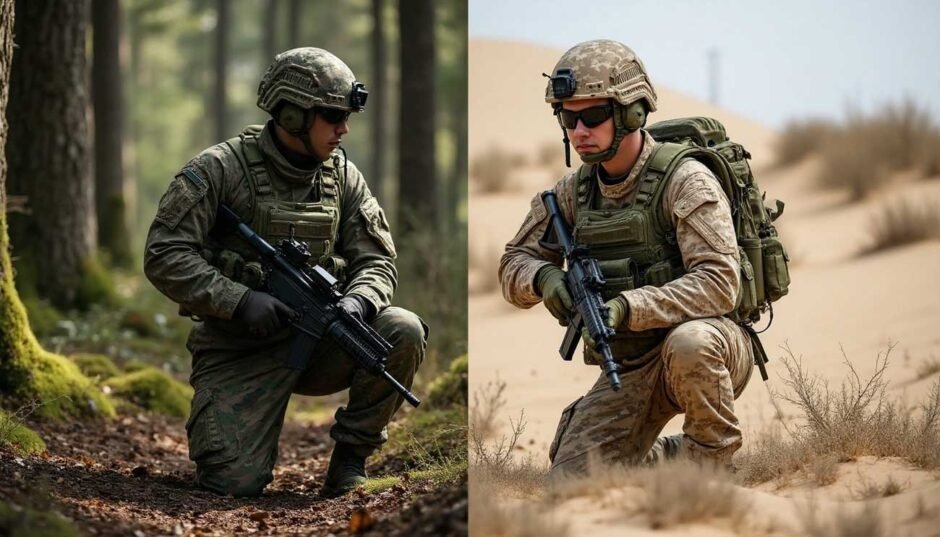Tarnplanen comes from the German word for “camouflage” and serves as a specialized material that helps you blend seamlessly into your surroundings. The sort of thing I love about this tactical fabric is its rich history, which shows how people needed to conceal themselves in a variety of environments.
Ancient warriors first discovered the power of camouflage when they used natural pigments to paint their faces, while the earliest versions simply featured patterns painted onto fabric. The late 19th century brought the most important breakthrough with patterned fabrics specifically created to hide soldiers on the battlefield. Tarnplanen does more than just conceal – it boosts the element of surprise during tactical operations and promotes psychological advantages on the battlefield.
Modern versions have changed remarkably. These lightweight yet durable materials now adapt to environments of all types – from forests and deserts to urban settings. Military forces worldwide continue to push innovation forward by using advanced materials that boost camouflage capabilities for the best tactical advantage.
What is Tarnplanen and Where Did It Come From?
The term “Tarnplanen” combines two German words: “Tarn” meaning camouflage or concealment, and “Planen” referring to tarpaulins or covers. These words create the meaning “camouflage tarpaulins” or “camouflage sheets”. This military equipment’s story goes back to the tactical warfare breakthroughs of the early 20th century.
Origins in military history
Tarnplanen’s story began on the battlefields of World War I. Military strategists realized they needed better ways to hide their forces. The German military led the way in specialized camouflage techniques that changed how battles were fought. They created these techniques because aerial reconnaissance and long-range weapons became more advanced. Armies needed quick and reliable ways to stay hidden.
World War II saw Tarnplanen become standard military gear. German forces found creative ways to use it beyond just hiding equipment. These versatile tarps worked as shelter halves that connected to form tents. Soldiers used them as ponchos in bad weather, ground covers, and even stretchers to carry the wounded.
Tarnplanen brought a fundamental change to military strategy. The focus moved from raw power to stealth and tactical advantage. These camouflage technologies showed that visual deception had become crucial to modern military tactics.
Evolution from painted fabrics to smart textiles
The original Tarnplanen had simple patterns painted on fabric. These patterns confused the eye and broke up shapes on the battlefield. Time and technology turned these simple camouflage materials into something much more advanced.
Better polymer technology and environmental testing created lighter, stronger, and more versatile materials. Today’s versions have multiple layers, resist water and UV rays, and come with reinforced corners and heat-sealed seams. New printing methods allow for detailed, high-definition patterns that match different environments with amazing accuracy.
After the war, Tarnplanen found its way into civilian life. Outdoor enthusiasts, campers, survivalists, and hunters started using these military-grade camouflage tarps. They loved how durable the tarps were and how well they could hide things.
The latest breakthroughs involve smart textiles – materials that adapt to their surroundings by changing color or pattern based on environmental signals. This represents cutting-edge camouflage technology. Some modern versions can respond to different terrains and conditions on their own.
How Tarnplanen Works in Military Camouflage
Military tarnplanen works through advanced concealment principles that have emerged from decades of battlefield innovation. These specialized camouflage tarps play vital roles by hiding vehicles, weapons, supply depots, and temporary observation posts from enemy detection.
Disruptive patterns and visual confusion
Tarnplanen’s success comes from its disruptive coloration patterns. These patterns do more than match colors – they break up outlines and create visual confusion for observers. High-contrast geometric shapes interfere with motion detection systems in visual perception, which makes it hard to identify the speed or path of hidden objects. The patterns also use Gestalt psychology principles that confuse how our brains process visual information.
The science behind this visual disruption shows how contrasting shapes and random patterns make objects appear as multiple smaller pieces instead of one recognizable shape. This tricks both human observers and digital surveillance systems effectively.
Material composition and durability
Today’s tarnplanen uses synthetic fibers like polyester or nylon, which we selected for their strength, resistance to tears, and quick-drying features. These materials get special treatments with polyurethane (PU) or polyvinyl chloride (PVC) coatings that make them waterproof and UV resistant.
Military-grade tarnplanen comes with metal eyelets or plastic grommets along the edges that let you anchor them securely with paracord, stakes, or clips. This tough design works well in harsh battlefield conditions and stays strong through rain and intense sun.
Digital printing and environmental mimicry
Recent advances in digital printing have brought unprecedented accuracy to pattern creation. The groundbreaking pixelated or “digital camouflage” from the early 2000s uses small squares that hide shapes better than older designs. These digital patterns can fool both human eyes and optical surveillance equipment.
Each environment needs its own pattern set. Woodland camouflage uses greens, browns, and blacks. Desert versions have light browns and tans. Urban designs mix grays and blacks. Some advanced models even reduce infrared signatures, making them harder to spot with thermal imaging.
Types of Tarnplanen for Different Terrains
A significant feature of effective tarnplanen lies in its terrain-specific design adaptation. Each pattern serves a distinct purpose based on the operational environment.
Forest camouflage: greens and browns
Forest-specific tarnplanen uses dark greens, browns, and blacks in patterns that mirror natural foliage and woodland settings. These designs disrupt solid outlines and help personnel blend naturally with their surroundings. The patterns mirror tree bark, leaves, and undergrowth. They create depth through careful placement of light and shadow elements. Woodland camouflage creates visual confusion with multiple shades that reflect nature’s variations in dense forest areas. This tarnplanen works best in environments with thick vegetation cover. The abundance of natural textures provides excellent hiding spots.
Desert camouflage: sandy and taupe tones
Desert tarnplanen features sandy hues mixed with light browns and taupe tones that match the natural landscape. These colors help troops stay hidden among dunes and scrub vegetation. Different variants have emerged over time. The “chocolate chip” pattern shows brown and black chips on tan backgrounds. The modern MultiCam Arid design features subtle blends of beige and muted earth tones. Desert camouflage performs well in both open sandy terrain and rocky landscapes. It adapts to the challenges of big expanses with minimal vegetation.
Urban camouflage: grays and geometric patterns
Urban environments need different approaches. The tarnplanen here mimics concrete and steel structures. These patterns use gray, black, and concrete-colored elements in geometric configurations. Some urban designs include elements that look like graffiti or shadows. This proves useful for tactical positioning in city settings. Urban camouflage science focuses on disrupting human-made structural outlines rather than blending with natural elements. This specialized approach makes urban tarnplanen effective for operations in industrial zones or populated areas where nature-based patterns would stand out.
Modern Innovations and Ethical Considerations
Military camouflage has redefined the limits of traditional fabric designs and moved toward revolutionary smart materials. The European Defense Agency now leads major projects to improve battlefield concealment using state-of-the-art technology.
Smart textiles and adaptive materials
The Advanced Solutions for Camouflage of Land Systems (ASCALS) project marks a major advancement with its €1.3 million investment. The project develops materials for active and adaptive camouflage that work across visible, infrared, and radar ranges. These materials counter sophisticated detection systems without adding extra weight or reducing vehicle mobility.
Scientists have created remarkable solutions like the Vanadium Oxide-Graphene-Carbon nanotube (VCG) film. This material completes phase transition with minimal power supply (approximately 4.2 mW/mm²). It achieves tunable emissivity of ~0.86 at 40°C and ~0.49 at 90°C, which helps manage thermal signatures under battlefield conditions.
Recent developments include thermochromic camouflage fabrics that respond to temperature changes. These fabrics transition between 30.7°C and 38.6°C based on their pigment composition.
Environmental impact of synthetic fabrics
Synthetic tarnplanen materials create serious environmental problems despite their technological benefits. Marine environments receive 200,000 to 500,000 tons of microplastic fibers from synthetic textiles yearly. Scientists have detected these microplastics in water, food products, and human lungs.
Manufacturing one kilogram of polyester fabric releases about 30kg of carbon dioxide equivalent. Textiles make up 13% of global plastic waste, ranking as the third largest contributor.
Concerns about misuse in covert operations
Advanced camouflage technologies present ethical challenges beyond environmental concerns. Critics warn that better concealment capabilities might enable covert operations that harm civilians. Intelligence operations’ political nature raises additional accountability questions.
Military advantages must be balanced against moral responsibilities as technology advances. Debates continue about regulating these powerful concealment technologies and preventing their misuse by state or non-state actors.
Conclusion
Tarnplanen has changed military tactics over the last several years. It started as simple painted fabrics and grew into advanced camouflage systems that naturally blend with many environments. Military forces around the world now rely on these specialized materials to gain tactical advantages during operations. Science and psychology work together to refine disruptive patterns that fool human perception and advanced detection systems.
The need for different terrain coverage has led to state-of-the-art designs for woodland, desert, and urban environments. Each variant plays a unique role and matches specific operational settings. These designs retain their durability and functionality in the field.
Smart textiles mark the next breakthrough in this field, but they bring new challenges. Scientists cannot ignore environmental issues from synthetic materials as microplastics build up in marine ecosystems. The ethical implications of advanced concealment technologies and their real-life applications need thorough review.
Military camouflage’s future lies where technology meets responsible use. Military strategists and scientists must balance tactical advantages with environmental sustainability and ethical deployment. Tarnplanen proves human ingenuity as it adapts to changing battlefield conditions and faces new challenges way beyond simple concealment.
FAQs
Q1. What is the primary purpose of military camouflage? The main objective of military camouflage is to deceive enemies about the presence, position, and intentions of military formations. It involves techniques like concealment, disguise, and the use of dummies to protect troops, vehicles, and positions from detection.
Q2. How does Tarnplanen work in military camouflage? Tarnplanen uses disruptive coloration patterns to break up outlines and create visual confusion. These patterns exploit principles of visual perception to make it difficult for observers to correctly identify the speed, trajectory, or even presence of camouflaged objects.
Q3. What are the different types of camouflage for various terrains? There are specific camouflage patterns for different environments: forest camouflage uses greens and browns, desert camouflage employs sandy and taupe tones, and urban camouflage incorporates grays and geometric patterns. Each is designed to blend into its specific environment.
Q4. What recent innovations have been made in military camouflage technology? Recent advancements include smart textiles and adaptive materials that can change color or pattern based on environmental cues. For example, thermochromic camouflage fabrics can change color in response to temperature shifts, enhancing concealment capabilities.
Q5. What ethical concerns are associated with advanced camouflage technologies? There are concerns about the potential misuse of advanced camouflage technologies in covert operations, which could potentially lead to civilian harm. Additionally, the development of these technologies raises questions about accountability and the need for regulation to prevent misuse by state or non-state actors.










